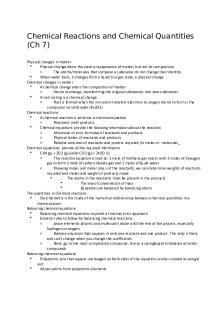Lab 3 Energy Changes in Chemical Reactions PDF

| Title | Lab 3 Energy Changes in Chemical Reactions |
|---|---|
| Author | Jade Boyd |
| Course | General Chemistry I |
| Institution | New Mexico State University |
| Pages | 3 |
| File Size | 74.5 KB |
| File Type | |
| Total Downloads | 44 |
| Total Views | 132 |
Summary
Lab 3 Energy Changes in Chemical Reactions...
Description
Jade Boyd
Chem 111 Lab 10/13/16
Energy Changes in Chemical Reactions
During a chemical reaction, bonds are broken and new bonds are formed. Energy is needed to break bonds and reactions that need energy are endothermic reactions. Reactions that release energy are called exothermic reactions. The objective of this experiment is to teach us to be able to determine the heat content of a substance and wether or not there is an endothermic reaction taking place or an exothermic reaction.
Heat of solution We started by observing the energy change that occurs when a solid is dissolved in water.
Solid
Ammonium Nitrate, NH4NO3
Calcium Chloride, CaCl2
Volume of water
100 mL
100 mL
Weight of solid
15g
15.01 g
Initial temperature of the solution
23 degrees celsius
23 degrees celsius
Final temperature of the solution
6 degrees celsius
52 degrees celsius
Change in temperature
17 degrees celsius
29 degrees celsius
Endothermic or Exothermic
Endothermic
Exothermic
Change in temperature per gram of solid
1.13 degrees celsius/ gram NH4NO3
1.932 degrees celsius/ gram CaCl2
The first reaction with Ammonium Nitrate was an endothermic reaction because the solution absorbed energy and had a drop in temperature. The second reaction with Calcium Chloride was an exothermic reaction because it released energy and showed an increase in temperature
Heat of Reaction For the second portion of our experiment, we conducted experiments to determine if the overall heat change in a chemical reaction is endothermic or exothermic. First we mixed Laundry Bleach and Sodium Sulfite. Mixture
Laundry Bleach and Sodium Sulfite
Temperature of Bleach in degrees celsius
23
Temperature of Sodium Sulfite in degrees celsius
23
Temperature of Mixture in degrees celsius
38
Change in temperature
25
This reaction was exothermic because it had an increase in temperature. Then for the next experiment we put 15 drops of water on a wooden block. On top of the block we placed a beaker with 20 g of Barium Hydroxide, Ba(OH)2 and 10 g of Ammonium Thiocyanate, NH4SCN. After 3-4 minutes the beaker was frozen to the block.
Heat of Combustion
This portion was to determine how much heat was produced when a substance burns. We placed a small candle and an index card on a balance and placed a clean cola can with water in it above the candle. Foil was placed on the top of the can to stop heat from escaping and the candle was lit for 2-3 minutes.
Initial
2-3 minutes later
Candle + Index Card Weight
12.725 g
12.654 g
Candle Weight
11.519 g
11.449
Index Card Weight
1.205 g
1.205
Temperature of water
22 C
26 C
Amount of water in can
100 mL
Water + Soda Can weight
109.710 g
Change in Temperature
4
Amount of Candle Burned
.017 g
Calories produced by paraffin
400
heat of combustion in joules
1673.6 Joules
These experiments went well. All of the data is recorded in the tables above. We used to equation for calculating calories and the conversion factor 1.0 calories=4.184 J for calculating joules. We noticed that our results on section 3, Heat of Combustion, were different than our classmates and a reason for this could be that our candle has a very small wick and very little wax around the wick. A solution to this problem would be that everyone had unused new candles for their experiments but this would not be cost effective. Another reason for the large range of results would be the distance from the flame to the can. If students were required to put the can an exact amount of centimeters from the flame this issue could be solved as well. Overall the experiment succeeded in showing us students the difference between an endothermic and an exothermic reaction and the different ways energy/heat is absorbed and released in reactions....
Similar Free PDFs

Chemical Changes Sehand IN COPY
- 13 Pages

Lab Experiment 4- Chemical Reactions
- 10 Pages

Physical and Chemical Changes
- 2 Pages

Exploring Chemical Physical Changes
- 10 Pages

Bitesize Notes - Chemical Changes
- 57 Pages

Gizmo Chemical Changes SE
- 12 Pages

Bill Nye Chemical Reactions
- 2 Pages
Popular Institutions
- Tinajero National High School - Annex
- Politeknik Caltex Riau
- Yokohama City University
- SGT University
- University of Al-Qadisiyah
- Divine Word College of Vigan
- Techniek College Rotterdam
- Universidade de Santiago
- Universiti Teknologi MARA Cawangan Johor Kampus Pasir Gudang
- Poltekkes Kemenkes Yogyakarta
- Baguio City National High School
- Colegio san marcos
- preparatoria uno
- Centro de Bachillerato Tecnológico Industrial y de Servicios No. 107
- Dalian Maritime University
- Quang Trung Secondary School
- Colegio Tecnológico en Informática
- Corporación Regional de Educación Superior
- Grupo CEDVA
- Dar Al Uloom University
- Centro de Estudios Preuniversitarios de la Universidad Nacional de Ingeniería
- 上智大学
- Aakash International School, Nuna Majara
- San Felipe Neri Catholic School
- Kang Chiao International School - New Taipei City
- Misamis Occidental National High School
- Institución Educativa Escuela Normal Juan Ladrilleros
- Kolehiyo ng Pantukan
- Batanes State College
- Instituto Continental
- Sekolah Menengah Kejuruan Kesehatan Kaltara (Tarakan)
- Colegio de La Inmaculada Concepcion - Cebu








